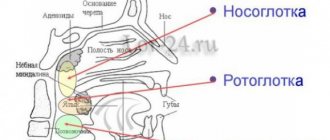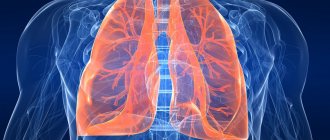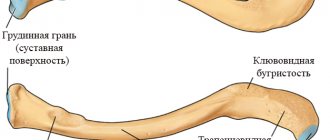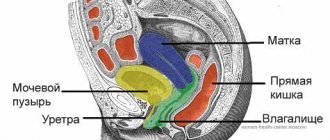(oropharynx) - part of the pharynx located between the soft palate and the hyoid bone (which is located next to the upper part of the epiglottis).
Share:
The pharynx is a cylindrical, slightly compressed in the sagittal direction, a funnel-shaped muscular tube 12 to 14 cm long, located in front of the cervical vertebrae. The vault of the pharynx (upper wall) connects to the base of the skull, the back part is attached to the occipital bone, the side parts to the temporal bones, and the lower part passes into the esophagus at the level of the sixth vertebra of the neck.
The pharynx is the crossroads of the respiratory and digestive tracts. During the swallowing process, food mass from the oral cavity enters the pharynx and then into the esophagus.
. Air from the nasal cavity through the choanae or from the oral cavity through the pharynx also enters the pharynx, and then into the larynx.
Structure of the pharynx
The anatomical structure of the pharynx is divided into three main parts - the nasopharynx (upper part), oropharynx (middle part) and hypopharynx (lower part). The oropharynx and nasopharynx are connected to the oral cavity, and the laryngopharynx is connected to the larynx
. The pharynx is connected to the oral cavity through the pharynx, and it communicates with the nasal cavity through the choanae.
The oropharynx is a continuation of the nasopharynx. The soft palate, palatine arches and dorsum of the tongue separate the oropharynx from the oral cavity
. The soft palate descends directly into the pharyngeal cavity. During swallowing and pronouncing sounds, the palate rises upward, thereby ensuring articulate speech and preventing food from entering the nasopharynx.
The laryngopharynx begins in the area of the fourth-fifth vertebrae and, smoothly descending, passes into the esophagus. The anterior surface of the laryngopharynx is represented by the area where the lingual tonsil is located
. Once in the oral cavity, food is crushed, then the food bolus enters through the laryngopharynx into the esophagus.
On the side walls of the pharynx there are funnel-shaped openings of the auditory (Eustachian) tubes. This structure of the pharynx helps to balance the atmospheric pressure in the tympanic cavity of the ear. In the area of these holes, tubal tonsils are located in the form of paired accumulations of lymphoid tissue
.
Similar accumulations are present in other parts of the pharynx. Lingual, pharyngeal (adenoid), two tubal, two palatine tonsils form a lymphoid ring (Pirogov-Waldeyer ring)
. The lymphoid ring prevents foreign substances or microbes from entering the human body.
The pharyngeal wall consists of a muscular layer, adventitia and mucosa. The muscular layer of the pharynx is represented by a group of muscles: the stylopharyngeal muscle, which lifts the larynx and pharynx, and voluntary paired striated muscles - the upper, middle and lower pharyngeal constrictors, which narrow its lumen
. When swallowing, the efforts of the longitudinal muscles of the pharynx rise, and the striated muscles, consistently contracting, push the food bolus.
Between the mucous and muscular layers there is a submucosa with fibrous tissue.
The mucous membrane in different locations is different in its structure. In the hypopharynx and oropharynx, the mucosa is covered with stratified squamous epithelium, and in the nasopharynx - with ciliated epithelium.
Diagnostics
After an examination by an oncologist and a dentist, a number of examinations are prescribed:
- blood test for HPV. The study is carried out using PCR, sequencing or enzyme analysis. Confirmation of human papillomavirus changes tumor treatment tactics;
- endoscopic examination of the larynx and oropharynx using laryngoscopy and pharyngoscopy;
- cytological examination. During laryngoscopy, the doctor takes a scraping from the mucous membrane and sends it for analysis. The cellular composition of the tumor is determined;
- biopsy. The removed area is stained with eosin and hematoxylin, and then a reaction to the drug is observed;
- CT/MRI. Tomography clarifies the location and size of the tumor;
- PAT. Shows the spread of the tumor to surrounding organs, as well as metastasis to the chest organs.
Functions of the pharynx
The pharynx takes part in several vital functions of the body at once: eating, breathing, voice formation, and defense mechanisms.
All parts of the pharynx are involved in the respiratory function, since air entering the human body from the nasal cavity passes through it.
The voice-forming function of the pharynx is to form and reproduce sounds produced in the larynx. This function depends on the functional and anatomical state of the neuromuscular apparatus of the pharynx. During the pronunciation of sounds, the soft palate and tongue, changing their position, close or open the nasopharynx, ensuring the formation of timbre and pitch of the voice.
Pathological changes in voice can occur due to impaired nasal breathing, congenital defects of the hard palate, paresis or paralysis of the soft palate. Nasal breathing disorders most often occur due to enlargement of the nasopharyngeal tonsil as a result of pathological proliferation of its lymphoid tissue
.
The growth of adenoids leads to an increase in pressure inside the ear, while the sensitivity of the eardrum is significantly reduced
. The circulation of mucus and air in the nasal cavity is inhibited, which promotes the proliferation of pathogens.
The esophageal function of the pharynx is to form the acts of sucking and swallowing. The protective function is performed by the lymphoid ring of the pharynx, which, together with the spleen, thymus and lymph nodes, forms a single immune system of the body
.
In addition, there are many cilia on the surface of the pharyngeal mucosa. When the mucous membrane is irritated, the muscles of the pharynx contract, its lumen narrows, mucus is released and a pharyngeal gag-cough reflex appears
. With a cough, all harmful substances adhering to the eyelashes are expelled.
Found an error in the text? Select it and press Ctrl + Enter.
Do you know that:
Human blood “runs” through the vessels under enormous pressure and, if their integrity is violated, it can shoot at a distance of up to 10 meters.
The cough medicine “Terpinkod” is one of the top sellers, not at all because of its medicinal properties.
More than $500 million a year is spent on allergy medications in the United States alone. Do you still believe that a way to finally defeat allergies will be found?
Over the course of a lifetime, the average person produces no less than two large pools of saliva.
Millions of bacteria are born, live and die in our intestines. They can only be seen under high magnification, but if they were put together, they would fit in a regular coffee cup.
Each person has not only unique fingerprints, but also tongue prints.
Besides people, only one living creature on planet Earth suffers from prostatitis - dogs. These are truly our most faithful friends.
It was previously believed that yawning enriches the body with oxygen. However, this opinion has been refuted. Scientists have proven that yawning cools the brain and improves its performance.
A job that a person doesn’t like is much more harmful to his psyche than no job at all.
In order to say even the shortest and simplest words, we use 72 muscles.
According to WHO research, talking on a mobile phone for half an hour every day increases the likelihood of developing a brain tumor by 40%.
In an effort to get the patient out, doctors often go too far. For example, a certain Charles Jensen in the period from 1954 to 1994
. survived more than 900 operations to remove tumors.
Research shows that women who drink several glasses of beer or wine per week have an increased risk of developing breast cancer.
American scientists conducted experiments on mice and came to the conclusion that watermelon juice prevents the development of vascular atherosclerosis. One group of mice drank plain water, and the second group drank watermelon juice. As a result, the vessels of the second group were free of cholesterol plaques.
Regular use of a solarium increases your chance of developing skin cancer by 60%.
Note to parents: what you need to know about influenza and ARVI
It is known that children get sick 5-10 times more often than adults. Therefore, experienced parents are familiar with the symptoms and even methods of treating most childhood ailments. But yes…
Morphological and syntactic properties
oropharynx
Noun, inanimate, feminine (type of declension ?? according to the classification of A. A. Zaliznyak).
Root: —
.
Pronunciation
Semantic properties
Meaning
- oral part of the pharynx?◆ The head intestine, or oropharynx
, in turn is divided into the oral cavity with walled salivary glands and the pharynx.
A.I. Akaevsky, “Anatomy of the reindeer”, 2013
Synonyms
- partially:
Antonyms
Hypernyms
Hyponyms
Related words
| Closest relationship | |
| |
Treatment
Depending on the stage of the disease and the patient’s condition, the doctor prescribes chemotherapy, radiation therapy, surgery, targeted therapy, immunotherapy in combination with each other or separately.
As a rule, during surgery, doctors try to save the organ if the cancer cells have not metastasized. If metastases are detected in the lymph nodes, blood vessels, or cells have grown into the nerve trunk, chemotherapy is carried out together with radiation. Targeted therapy is used for oropharyngeal cancer caused by HPV-associated squamous cell carcinoma. Based on practice, in this case the results are favorable.
After completing the course of treatment, patients are observed by an oncologist and a dentist. Visiting doctors is mandatory every 3-6 months for the first two years. For the next five years, inspections are carried out every six months to a year. For the next five years, the patient visits the doctor once a year or more often if unwell. During the visit, the doctor analyzes the patient’s condition, taking into account the results of fiberoscopy, annual radiography of the chest organs, ultrasound of the lymph nodes, pelvic organs and abdominal organs.
Pharynx
text_fields
text_fields
arrow_upward
The pharynx (pharynx) is a muscular organ with a fibrous base that connects the oral cavity to the esophagus and the nasal cavity to the larynx. In the pharynx, the digestive tract is crossed by the respiratory tract (see
.
Atl.). The length of the pharynx of an adult is 12-15 cm. The pharynx is attached by the expanded part (vault) to the base of the skull, and the lower narrowed part at the level of the VI cervical vertebra passes into the esophagus
.
Between the vertebral bodies and the posterior wall of the pharynx there is a retropharyngeal space filled with loose connective tissue. This allows for significant movement of the pharynx during swallowing
. The pharynx is divided into three sections - the nasopharynx, oropharynx and laryngeal part.
Nasopharynx
text_fields
text_fields
arrow_upward
The nasopharynx is the uppermost, complex part of the pharynx. Through the choanae it communicates with the nasal cavity. The nasopharynx is separated from the oral cavity by the soft palate, which fits tightly to the root of the tongue when breathing, and when swallowing, on the contrary, separating it from the rest of the pharynx. On the lateral walls of the nasopharynx at the level of the choanae there are openings of the auditory (Eustachian) tubes
. By connecting the nasopharynx with the middle ear cavity, these tubes ensure equalization of air pressure in the middle ear with external pressure. Between the opening of the auditory tube and the soft palate lies the tubal tonsil, and on the arch of the nasopharynx lies the pharyngeal tonsil.
Symptoms
Unfortunately, there are no specific signs of the development of a malignant neoplasm in the oropharynx. The patient should be alert to the following symptoms:
- long-lasting sore throat;
- sensation of a foreign object in the throat;
- discomfort when swallowing food or saliva;
- difficulty chewing;
- whitish spots on the mucous membrane with a red border;
- numbness of the root of the tongue;
- ball when palpating the neck;
- rough or hoarse voice;
- bad breath;
- unreasonable weight loss.
The insidiousness of the disease in its latent course at the first stage. The disease does not manifest itself in any way, so the person does not seek medical help. Already at stages 2-3, a palpable nodule in the neck begins to hurt and is felt more strongly. The cervical lymph nodes are enlarged. At stage 4 of oropharyngeal cancer, the respiratory and swallowing process is disrupted, and the tumor spreads to surrounding tissues. The disease is aggravated by hemoptysis, rapid weight loss, exhaustion and anorexia. Sometimes there is blood coming from the mouth. If the tumor has compressed the masticatory muscles or nerve plexuses, muscle movement is limited.
Metastases develop faster than the tumor itself.
Oropharynx
text_fields
text_fields
arrow_upward
The oropharynx communicates with the oral cavity through the pharynx (see Atl.). Tapering downwards, it passes into the laryngeal part of the pharynx, the anterior wall of which is adjacent to the posterior surface of the larynx.
In newborns, the pharynx is wide and short, located high. Until the age of 5, it grows mainly in width, and after 14 years, its rapid growth in length begins. By the age of 18, the pharynx reaches the size of an adult.
.
The development of the pharynx, and especially the nasopharynx, is associated with the development of the facial part of the skull. In children, the auditory tube is short and located horizontally
.
Its external opening is wide
. This makes it possible for infection to quickly penetrate the middle ear cavity.
The outside of the pharynx is covered with an adventitial membrane, which passes from below to the esophagus.
Prevention
Cancer can be prevented by following a number of recommendations from experts. First of all, it is important to properly care for your oral cavity and visit the dentist in a timely manner. The doctor keeps your teeth clean and monitors the condition of your gums and soft tissues twice a year.
Since HPV is a significant factor in the development of oropharyngeal cancer, it is important to reduce the risk of infection. To do this, it is necessary to exclude promiscuity and get a vaccine.
Experts recommend giving up bad habits and completely quit smoking. Immediately after eating, you should rinse your mouth and brush your teeth twice a day. A balanced diet is the key to health, so you should consume more vegetables and fruits every day, eat whole grain bread, and it is better to avoid processed meat, legumes and chicken.
Bibliography:
- American Society of Clinical Oncology. Oral and Oropharyngeal Cancer: Screening. 09/2017. Accessed at www.cancer.net/cancer-types/oral-and-oropharyngeal-cancer/screening on February 21, 2021.
- National Cancer Institute. Oral Cavity, Pharyngeal, and Laryngeal Cancer Screening (PDQ®)–Health Professional Version. February 9, 2021. Accessed at www.cancer.gov/types/head-and-neck/hp/oral-screening-pdq#section/_1 on February 21, 2021.
- International Union Against Cancer (UICC). Lip and Oral Cavity. In: UICC TNM Classification of Malignant Tumors, 7th Edition. 2009:328.
- National Comprehensive Cancer Network, Clinical Practice Guidelines in Oncology (NCCN Guidelines®), Head and Neck Cancers, Version I. 2021 - February 15, 2021. Accessed at www.nccn.org/professionals/physician_gls/pdf/head-and-neck .pdf on February 21, 2021.
- American Cancer Society.Facts & Figures 2021. American Cancer Society. Atlanta, Ga. 2021.
- American Cancer Society. Cancer Facts & Figures 2021. Atlanta, Ga: American Cancer Society; 2021.
- National Cancer Institute. Cancer Stat Facts: Oral Cavity and Pharynx Cancer. April 2021. Accessed at https://seer.cancer.gov/statfacts/html/oralcav.html on February 22, 2018.
- National Cancer Institute. Lip and Oral Cavity Cancer Treatment (Adult) (PDQ®)–Patient Version. January 29, 2021. Accessed at www.cancer.gov/types/head-and-neck/patient/adult/lip-mouth-treatment-pdq on February 22, 2021.
- Squamous cell carcinoma of the head and neck: new avenues of treatment? // Braunschweig1 , A. Lewandrowski1 , D. Smeets1 , MV Bolotin2
- Bolotina L.V., Vladimirova L.Yu., Dengina N.V., Novik A.V., Romanov I.S. Practical recommendations for the treatment of head and neck tumors. Malignant tumors. 2021.
Muscular wall of the pharynx
text_fields
text_fields
arrow_upward
The muscular wall of the pharynx is built of striated muscles, which consists of three pairs of flat circular compressor muscles and two pairs of weak muscles with longitudinal fibers that lift the pharynx (see Atl.). Consecutive contraction of the constrictor muscles (as well as the muscles of the soft palate and tongue) during the passage of a bolus of food causes the act of swallowing
. The pharyngeal muscles are innervated by the vagus and glossopharyngeal nerves.
Mucous membrane of the nasopharynx
text_fields
text_fields
arrow_upward
The mucous membrane of the nasopharynx, as well as the nasal cavity, is lined with multirow ciliated epithelium. The remaining parts of the pharynx are lined with stratified squamous non-keratinizing epithelium
. The mucous membrane contains small mucous glands scattered throughout all its sections.
In the wall of the pharynx, under the epithelium, there are accumulations of lymphoid tissue - tonsils: unpaired pharyngeal and lingual tonsils and paired tubal and palatine tonsils (clearly visible through the open mouth). They surround the entrance to the nasopharynx and oropharynx and form a lymphoepithelial ring (see
.
Atl.). Lymphocytes and numerous plasma cells multiplying in the tonsils perform a protective function, preventing the penetration of infection
.
Tonsils are especially developed in children. Tonsil damage occurs more often in children than in adults
.
A sharp increase in them is often the first sign of tonsillitis, scarlet fever, diphtheria and other diseases
.
The pharyngeal tonsil in adults is little noticeable or disappears altogether
. But in children it can be significant. With pathological growth (adenoids), it makes breathing through the nose difficult.
Chewing
text_fields
text_fields
arrow_upward
During chewing, food is ground in the oral cavity. Chewing involves the upper and lower jaws, teeth, tongue, cheeks, and masticatory muscles.
.
In this case, food is crushed, which greatly facilitates its subsequent digestion and absorption
.
Although chewing is a voluntary action, it is mainly carried out as an involuntary reflex act: when pieces of food come into contact with the palate and teeth, reflex chewing movements occur
.
In this case, food is moved using coordinated movements of the tongue and cheeks throughout the oral cavity. A full set of teeth is required to achieve maximum grinding of food
. During the chewing process, salivation is reflexively triggered. Food moistened with saliva is easily swallowed.










